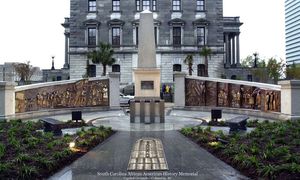Integrals of the whole
Monuments are a fundamental part of society. Particularly in America, where the vast majority of the population stems from immigration, it is important to have these monuments to celebrate or remember historical events and the culture that the monument commemorates. Memorials typically focus on one specific event or person because this allows a more advanced analysis and gratitude. Trying to fit all of a historical event into one monument belittles the crucial, specific elements of the event. Yet, most people still criticize memorials for their inability to encapsulate a full historical event. However, memorials do not need to represent a whole historical event to commemorate groups of people. In this digital exhibit, I will show that African-American memorials are able to significantly show migration without full representation of the history by carefully selecting which events to memorialize. These monuments that focus on a specific event are not only as significant as generalized memorials, but are even better at immortalizing history.
When trying to squeeze a whole cultural migration into a monument, the details get lost in the vastness of the memorial. The African-American monument in South Carolina is an example of a monument that loses detailed and intense emotion due to its extensive nature. This monument recognizes several migrational and cultural events, including: An engraving of packed bodies on a ship used to transport slaves, working slaves, the emancipation of slaves, African-American Civil War soldiers, African-American cultural movements into cities, Jim crow laws, Brown vs The Board of Education, the Civil Rights Movement, Harriet Tubman, the 14th amendment, segregation, and several other aspects of the culture. This is an overwhelming amount of topics and events, which are all fundamentally important to the migrational history of African-Americans, that are belittled and trivialized. When these many subjects are being presented to an audience, it is almost impossible to truly appreciate and commemorate each and every one of them to their full respect.
The defined subjects in specified memorials are able to be honored and remembered to their full merit. The Harriet Tubman memorial focuses on her specifically. She is an iconic American hero, as she helped hundreds of slaves escape captivity through the Underground Railroad. The audience is presented with one subject that obtains their full attention. By focusing on this one figure, the sculpture (Alison Saar) was able to add several interesting details that help commemorate and immortalize Harriet Tubman. The statue is facing south, which further recognizes her merit as it shows her fearlessly striding back towards the south to save more slaves. As she is facing south, roots are trailing her to show that she is destroying the “roots of slavery” (Alison Saar). The specification of Harriet Tubman allows for the stronger and more appropriate recognition of her bravery and valiance.








